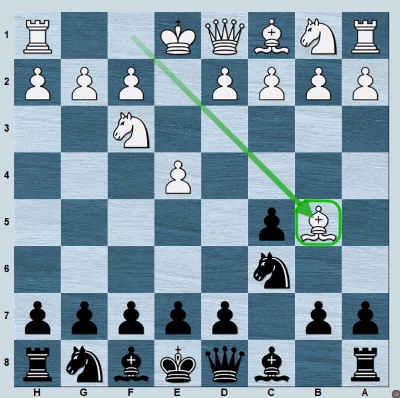When to Change Your Opening Repertoire
When should you change your openings? How to fix your opening repertoire? And more...
When should you change your openings? How to fix your opening repertoire? And more...

“The grass isn’t always greener on the other side. The grass is greener where you water it.”
One of the most common, and damaging mistakes that chess lovers make is changing their opening repertoire without a good reason.
It goes something like this…
They choose an opening, learn it for a while, and then begin to practice and play games with it. But after a couple of painful defeats, they start to tell themselves things like:
They get angry. They feel frustrated. They smash their new gaming mouse against their desk.
And then what do they do next? They do the same thing all over again... but with a different opening! 🙂
The cycle continues and many more gaming mice get destroyed 🙂
But the question they should be asking themselves is: Was it my fault, or the fault of the opening?
These days, it only takes a few seconds to check your game statistics online and see your win/draw/loss % for any of the openings you play.
Unfortunately, this has meant that it’s increasingly common for chess lovers to see which of their openings they have the worst results from and blame it for their losses.
Here are a few problems with this approach:
You can get a big advantage from the opening or have a decent position, but later lose because of a blunder. Or because of poor time management. Or because you didn’t convert a winning endgame.
In my article about learning the right lessons from your mistakes, I shared a joke:
“A man goes to a bar and orders a bottle of whiskey. After drinking it, he asks for another one, and then one more. After the 3rd bottle, totally drunk, he decides to eat a sandwich.
A few minutes later, because of too much alcohol in his blood, the man, totally drunk, falls onto the floor. A while later he opens his eyes and says “Eh… Everything was good, I just shouldn’t have eaten that sandwich.” 😅😅😅
In short, often the opening has nothing to do with the end result.
Sometimes chess tools can be helpful, but they have a problem – they aren’t human. It’s well known that there are some openings that engines don’t fully comprehend at first glance like the King’s Indian, Grunfeld, Benko Gambit, Pirc Defense, etc.
For example, if you play the Benko Gambit as Black, some tools might feel that you have problems with Black and that you should change your opening.
Why? Because during the Benko Gambit you sacrifice a pawn very early on, and the engine doesn’t feel what will happen after the next 20 moves and how practical the position is to play.
And what will they tell you?
“You have problems with the Benko Gambit, change it.”
There are a few reasons.
When you start learning a new opening, no matter if you’re rated 1,000 or 2,500, you’re effectively a beginner there.
Initially, you won’t be in your comfort zone, you won’t know all the ideas of the positions, and at first, you might forget the opening moves and move orders.
It’s not okay. It’s not fine. It’s more than fine!
We talked a lot in our articles about it being very good to be out of your comfort zone. It’s where you grow.

Keep going! The results of your first games when trying a new opening may be bad, but try not to worry about it. Instead, try to embrace the learning curve.
You might feel that you’re doing bad in a particular opening, or in a variation, when in fact, you’re not!
Recently, a friend of mine said he does badly playing the French Defence with our tricky 3.Bd3 move.

But after checking his games, we found that out of 50 games:
The thing was, that he screwed up in the last 3 games! He had a feeling he was doing badly in the opening, but he’d forgotten all his previous games when he was crushing it.
One of my students said he hates playing against the Rossolimo. So after 1.e4 c5 2.Nf3, he wants to learn 2...g6, to avoid 2...Nc6 3.Bb5.

We downloaded all of his games he’d played against the Rossolimo and we saw an interesting picture.
From 40 games, he went wrong in 32 of them! Often he made a wrong move right in the opening and got bad positions. And out of the 8 remaining games, he chose the wrong plan in 6 of them.
What was his problem?
He didn’t watch the course carefully enough or make his own PGN files. He didn’t do what was necessary to remember and understand the opening.
But still, he had blamed his opening choice.
After we fixed all the mistakes, he rewatched the course, made some PGN files, and started to crush the Rossolimo.
Sometimes I hear people say:
“I played this opening against the engine. It kills me. I want to try something different.”
Well, if you play against a strong engine, it won’t matter which opening you choose. And not just you. Me, Nakamura, or Carlsen 🙂
If you love to play against engines (which I don’t recommend at all), play against it with reversed colors. Then you’ll see how good the opening is, which you didn’t like playing at first 🙂
Well, you shouldn’t stop playing your opening after playing a match against a much stronger opponent or a specialist of that opening.
Equally, if you lose a match to your training partner whom you analyzed your variations with deeply – it’s okay.
When your partner knows what you’ll play in advance, they have time to sit, analyze and find the best moves among 15 possible options. In practical games against others, your opponents will not have that advantage.
Lastly, if you do okay against your training partner, it’s a sign you’ll probably crush others of similar strength.
If you read our blogs or watch our courses regularly, you’ll know the steps. Here, we’ll summarize them in short:
You might learn your openings from courses, books, or a coach. Be focused during your study time and pay attention to ideas, not just memorizing the moves.
It will help you to memorize and understand your openings better when you create your own PGN files, rather than downloading a ready-made one.
No matter if you play a classical game or a blitz game, be sure to analyze it. Check the opening phase, compare it with your files/books/course, and then see what you did wrong.
If the author provided model games with the openings they taught you, watch them. It's a must for understanding your openings better.
For example, during ChessMood’s streams, we only play the openings that we teach in our courses. I think this is one of the main reasons that our students raise their ratings so quickly.
You can go further too. Let’s say you learned how to play against the Caro-Kann, but you don’t feel very confident about the plans when Black plays the move e6 early.
If you use ChessBase, you can set up the position and search for games. Then you click “ELO White” (or Black, depending on which side you play), and watch some games.

When you learn your opening by understanding it, rather than trying to just memorize it, 99% of the time, you’ll start to feel comfortable playing it.
Also, this training technique that Grandmasters use can help you deeply understand the lines in this process.
Still, there may be a few occasions changing your opening repertoire is the right decision:
You did all the necessary steps, understand all the positions, but it still doesn’t make you excited to play it. You just don’t enjoy the opening. If that’s the case, then go ahead and try a different opening.
Just don’t lie to yourself.
You should try to answer these questions honestly:
• Do I remember the opening moves and play everything correctly in the opening?
• Do I understand the positions well?
If the answer to both of these questions is “yes” and you still don’t like your opening, then you can move on.
For example, if you play the Stafford Gambit or Latvian Gambit, you might get good results against opponents rated below 1,500. But after that, you’ll start to have problems.
No matter how well you understand a dubious opening, if your opponent knows how to refute it, you’ll be in trouble.
So to grow your level, you might need to learn more fundamental openings.
Sometimes you’ll start your career with the wrong opening. Someone will sell you a course or try to persuade you that the particular opening is best.
Then you feel that it’s too complicated for your level (you’re a beginner, you play Najdorf but you have just 1 hour a day to study chess) or you play some boring systems, getting every time the same type of positions and not growing fast enough.
In such cases you might need to change the opening. But you shouldn't do it, before consulting a very experienced coach whom you fully trust.
This is a rare case, and it may sound a little strange, no?
Why do you need to change your opening if you feel very comfortable with it? You don’t necessarily need to if you want to have some openings that you play for fun. Or you want to stick to a fundamental opening and focus your learning on middlegames and endgames.
The rare case is when you’re a professional. Let’s say you’re an IM and want to become a GM. Whenever you find yourself in your comfort zone, you should try to move out of it because that’s where your biggest source of growth is.
It doesn’t mean you should forget your opening. You can keep it as a strong weapon. But you’ll need to take yourself to an uncomfortable zone again, in order to progress faster and learn alternative openings.
Did you notice that Grandmasters usually play multiple openings? 🙂
***
Okay, champions, these are the 4 situations when it might be wise to change your opening or learn a new one.
In other instances, keep faith in your openings, work hard to master them, and enjoy playing this awesome game.
P.S. Feel free to share your thoughts, stories, and experiences about this in our forum.
Originally published May 31, 2021

